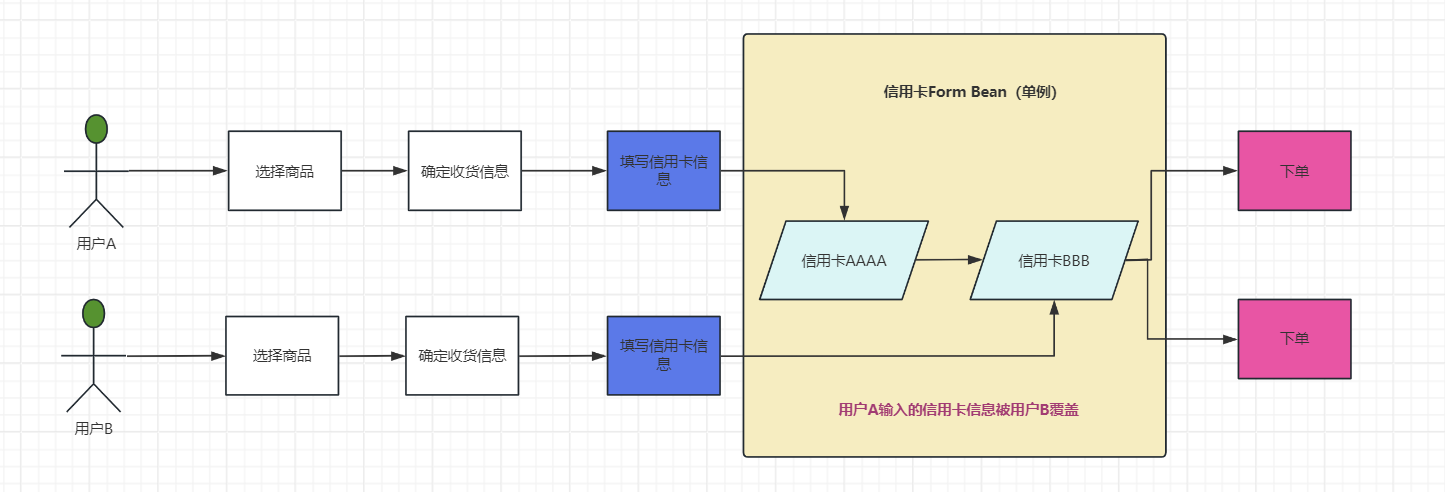背景介绍
我们项目是一个小型的隐形眼镜电商网站,运行时间有十几年了。
项目技术采用的Struts1 + Hibernate + Oracle,由于Struts1版本存在漏洞风险,所以需要升级到Struts2。
线上问题
我们收到客户的邮件说,他的信用卡有两笔支付记录,但是他只下过一单。
排查过程
我们在数据库查了他的信用卡支付记录,确实有两笔支付记录,并且下单用户不同,购买的商品不同,收货地址距离不同并且相距很远。于是排除了重复扣款的可能。可以确认就是两个用户的订单,使用了同一张信用卡支付。
我们下面将没有花钱就买到了商品的用户成为用户A,而这位被多刷信用卡的用户成为用户B
我们一开始对于这个问题毫无头绪,就猜测是不是用户信用卡被盗了(哈哈哈哈,我们的代码怎么可能有问题),但迫于客户的压力,我们还是调查一下代码。
我逐行排查信用卡下单的代码,还真有所发现,有一处代码,大概长这样:
此处代码的主要作用是保存用户输入的信用卡数据
private PaymentForm paymentForm = new PaymentForm();
....省略N行代码
cartService = ServiceLocator.getInstance().getCartService();
// 从购物车表查询商品数据
CartDTO cartDTO = cartService.findCartDtoByConsumerId(sessionData.getConsumerProfileDTO().getConsumerID());
// 前端传进来的数据都在paymentForm中,将这些信息放入cartDTO对象
cartDTO.setCcExpMonth(paymentForm.getExpirationMonth());
cartDTO.setCcExpYear(paymentForm.getExpirationYear());
cartDTO.setCcToken(paymentForm.getCcToken());
cartDTO.setCcType(paymentForm.getCardType());
cartDTO.setCcHolder(paymentForm.getNameOnCard());
// 更新用户的信用卡数据
cartService.updateConsumerCart(sessionData.getConsumerProfileDTO().getConsumerID(), cartDTO);
在并发情况下,这里我假设用户B的请求却拿到了用户A的 session,那么 session 中存储的用户ID也就拿错了,用户B的信用卡数据就有可能保存到用户A的账号上。
然后我再去查了查 session 的底层原理,发现我错了,session 有自己的管理机制,不会发生“串台”的情况,并且在集群情况下,就算没有做session同步处理,那最多也只是程序拿不到session数据,于此我的假设被推翻。
另一个同事问Form数据会不会“串台”呢,我第一反应是:不会,但还是去看了下 Form 类。前面还提到了项目需要从 struts1 升级到2,这个问题也是升级到 struts2 后出现的,我顺便去看了一下这次升级做了哪些修改。
问题原因
struts 框架有 Action 和 Form 的概念,Action 相当于 Spring 中的 controller,Form 相当于 Spring 中封装请求数据的 RequestDTO 对象
Struts1 是这么写的
<form-beans>
<form-bean name="paymentForm" type="com.test.web.forms.PaymentForm" />
</form-beans>
<action path="/checkout/submitPayment" type="com.test.web.actions.CheckoutAction" parameter="paymentPreAuth" name="paymentForm" >
<forward name="error" path="/error.html" />
</action>
Struts2 升级后,引入了 Spring 来管理 Bean,这么写的
<beans>
<bean id="paymentForm" class="com.test.web.forms.PaymentForm"/>
</beans>
看起来没什么毛病,但是有一个重要的点被忽视了,那就是 Spring Bean 的默认 scope。
<xsd:attribute name="scope" type="xsd:string">
<xsd:annotation>
<xsd:documentation><![CDATA[
The scope of this bean: typically "singleton" (one shared instance,
which will be returned by all calls to getBean with the given id), or
"prototype" (independent instance resulting from each call to getBean).
By default, a bean will be a singleton, unless the bean has a parent
bean definition in which case it will inherit the parent's scope.
Singletons are most commonly used, and are ideal for multi-threaded
service objects. Further scopes, such as "request" or "session", might
be supported by extended bean factories (e.g. in a web environment).
Inner bean definitions inherit the scope of their containing bean
definition, unless explicitly specified: The inner bean will be a
singleton if the containing bean is a singleton, and a prototype if
the containing bean is a prototype, etc.
]]></xsd:documentation>
</xsd:annotation>
</xsd:attribute>
Spring Bean 默认是 singleton,而 Struts1 中 Form 的 scope 默认是 session。
那么全局只有一个 PaymentForm, 在并发情况下,就会出现不同用户提交的 PaymentForm 数据被重写,最后保存表单数据到数据库时是使用的最后提交的那个用户的数据。
我们通过一个流程图来看看这次事故发生的流程。
流程图

两个用户几乎同时提交了信用卡信息,但是用户B的数据存入 paymentForm 的时机稍微晚一点。两个用户都保存了用户B的信用卡信息,最后下单支付都用了用户B(倒霉蛋)的卡。
修复方案
PaymentForm Bean 添加 scope 为 prototype。
<beans>
<bean id="paymentForm" class="com.test.web.forms.PaymentForm" scope="prototype" />
</beans>

%20(1).jpg)

评论区